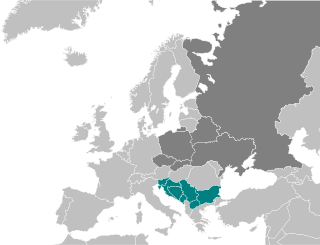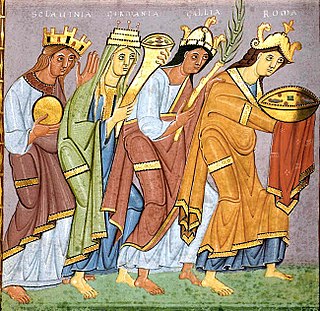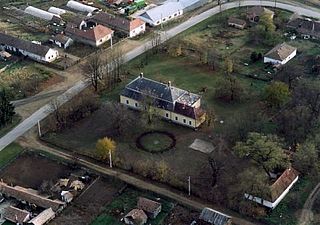
Pan-Slavism, a movement which crystallized in the mid-19th century, is the political ideology concerned with the advancement of integrity and unity for the Slavic people. Its main impact occurred in the Balkans, where non-Slavic empires had ruled the South Slavs for centuries. These were mainly the Byzantine Empire, Austria-Hungary, the Ottoman Empire, and Venice.
The Slavs or Slavic people are a grouping of related ethnic groups which speak the various Slavic languages, belonging to the larger Balto-Slavic branch of the Indo-European language family. Slavs are geographically distributed throughout the northern parts of Eurasia; they predominantly inhabit Central Europe, Eastern Europe, and Southeastern Europe, though there is a large Slavic minority scattered across the Baltics, Northern Asia, and Central Asia, as well as Japan and Australia. Continued immigration has resulted in the development of a substantial Slavic diaspora in the Americas, including the United States, Canada, Mexico, Brazil, Argentina and Chile.

The East Slavs are the most populous subgroup of the Slavs. They speak the East Slavic languages, and formed the majority of the population of the medieval state Kievan Rus', which they claim as their cultural ancestor. Today, the East Slavs consist of Belarusians, Russians, Rusyns, and Ukrainians.

Slavic mythology or Slavic paganism is the religious beliefs, myths, and ritual practices of the Slavs before Christianisation, which occurred at various stages between the 8th and the 13th century. The South Slavs, who likely settled in the Balkan Peninsula during the 6th–7th centuries AD, bordering with the Byzantine Empire to the south, came under the sphere of influence of Eastern Christianity, beginning with the creation of writing systems for Slavic languages in 855 by the brothers Saints Cyril and Methodius and the adoption of Christianity in Bulgaria in 864 and 863 in Great Moravia. The East Slavs followed with the official adoption in 988 by Vladimir the Great of Kievan Rus'.
Anti-Slavic sentiment, also known as Slavophobia, a form of ethnic based prejudice or xenophobia, refers to various negative attitudes towards Slavic peoples, the most common manifestation a claim that inhabitants of Slavic nations are inferior to other ethnic groups. Anti-Slavism reached its peak during World War II, when Nazi Germany declared Slavs, especially neighboring Poles to be subhuman (Untermensch) and planned to exterminate the majority of Slavic people.
Antyfaszystowska Organizacja Bojowa, AOB, was an underground organization formed in 1942 in the Ghetto in Białystok by former officers of the Polish Land Forces. It took part in the Białystok Ghetto uprising.

Saqaliba is a term used in medieval Arabic sources to refer to Slavs, and other peoples of Central, Southern, and Eastern Europe. The term originates from the Middle Greek slavos/sklavenos (Slav), which in Hispano-Arabic came to designate first Slavic slaves and then, similarly to the semantic development of the term in other West-European languages, foreign slaves in general. The word was often used to refer specifically to Slavic slaves, but it could also refer more broadly to Central, Southern, and Eastern Europeans traded by the Arab traders, as well as all European slaves in some Muslim regions like Spain including those abducted from raids on Christian kingdoms of Spain.
The Buzhans were one of the tribal unions of Early Slavs, which supposedly formed East Slavs in Southern Russia and Volga region. They are mentioned as Buzhane in the Primary Chronicle. Several localities in Russia are claimed to be connected to the Buzhans, like for example Sredniy Buzhan in the Orenburg Oblast, Buzan and the Buzan river in the Astrakhan Oblast.
The Slav Defense is a chess opening that begins with the moves:

South Slavs are Slavic people who speak South Slavic languages and inhabit a contiguous region of Southeast Europe comprising the eastern Alps and the Balkan Peninsula. Geographically separated from the West Slavs and East Slavs by Austria, Hungary, Romania, and the Black Sea, the South Slavs today include Bosniaks, Bulgarians, Croats, Macedonians, Montenegrins, Serbs and Slovenes.
The Battle of Sebastopolis was fought at Sebastopolis in 692 CE between the Byzantine Empire and the Umayyad Caliphate under Abd al-Malik ibn Marwan. The battle ended the peace that had existed between the two powers since 680.

The West Slavs are Slavic peoples who speak the West Slavic languages. They separated from the common Slavic group around the 7th century, and established independent polities in Central Europe by the 8th to 9th centuries. The West Slavic languages diversified into their historically attested forms over the 10th to 14th centuries.

The Sclaveni or Sklabenoi were early Slavic tribes that raided, invaded and settled in the Balkans in the Early Middle Ages and eventually became the progenitors of modern South Slavs. They were mentioned by early Byzantine chroniclers as barbarians having appeared at the Byzantine borders along with the Antes, another Slavic group. The Sclaveni were differentiated from the Antes and Wends ; however, they were described as kin. Eventually, most South Slavic tribes accepted Byzantine or Frankish suzerainty, and came under their cultural influences and Chalcedonian Christianity. The term was widely used as a general catch-all term until the emergence of separate tribal names by the 10th century.

Patvarc is a village in Nógrád county, Hungary.

Áta is a village in Baranya county, Hungary.
The settlement of the Eastern Alps region by early Slavs took place during the 6th to 8th centuries. It is part of the southward expansion of the early Slavs which would result in the characterization of the South Slavic group, and would ultimately result in the ethnogenesis of present-day Slovenes. The Eastern Alpine territories concerned comprise modern-day Slovenia, Eastern Friuli, in modern-day Northeast Italy, and large parts of modern-day Austria.

Much of the territory of the modern state of Serbia was part of the Roman Empire and later the Eastern Roman Empire. In particular, the region of Central Serbia was under Roman rule for about 800 years, starting from the 1st century BC, interrupted by the arrival of the Slavs into the Balkans during the 6th century, but continued after fall of the First Bulgarian Empire in the early 11th century and permanently ended with the rise of the Second Bulgarian Empire in the late 12th century. The territories were administratively divided into the provinces of Moesia, Pannonia and Dardania. Moesia Superior roughly corresponds to modern Serbia proper; Pannonia Inferior included the eastern part of Serbia proper; Dardania included the western part of Serbia proper. After its reconquest from the Bulgarians by Emperor Basil II in 1018, it was reorganized into the Theme of Bulgaria.

The early Slavs were an Indo-European peoples who lived during the Migration Period and the Early Middle Ages in Central, Eastern and Southeast Europe and established the foundations for the Slavic nations through the Slavic states of the Early and High Middle Ages. The Slavs' original homeland is still a matter of debate due to a lack of historical records; however, scholars believe that it was in Eastern Europe, with Polesia being the most commonly accepted location.
Kuyaba was one of the three centers of the Rus or Saqaliba described in a lost book by Abu Zayd al-Balkhi and mentioned in works by some of his followers . The two other centers were Slawiya and Arthaniya.
Strymonites or Strymonian Slavs were a tribe of Sclaveni who settled in the region of the river Strymon (Struma) in eastern parts of the historical region of Macedonia.











